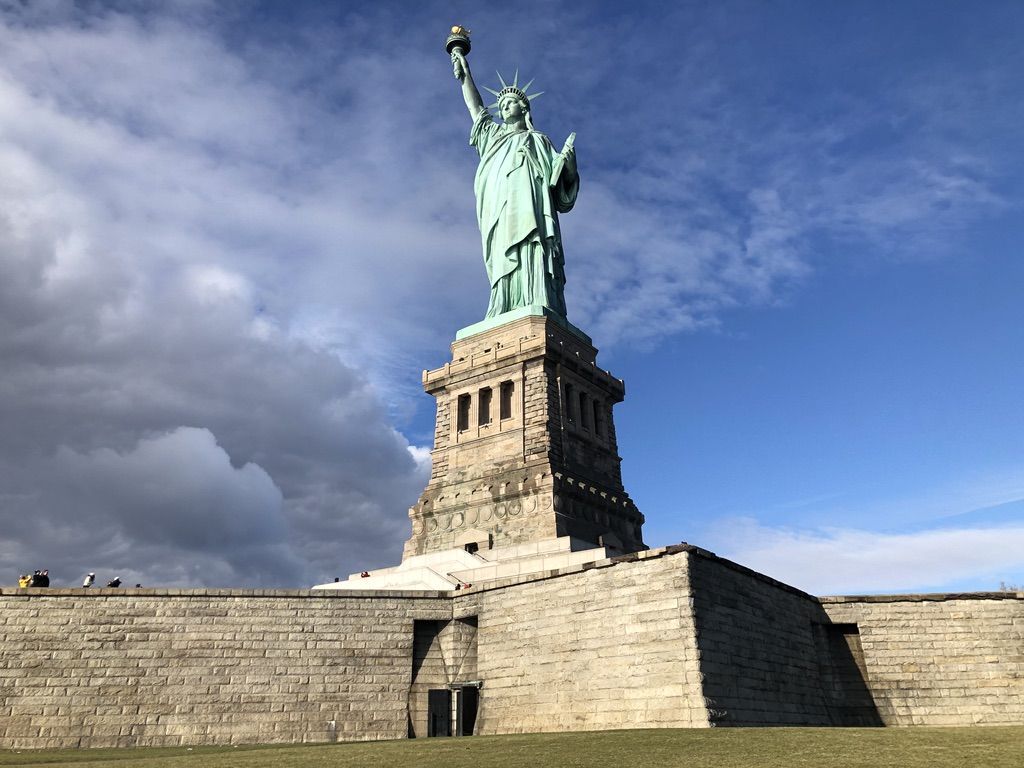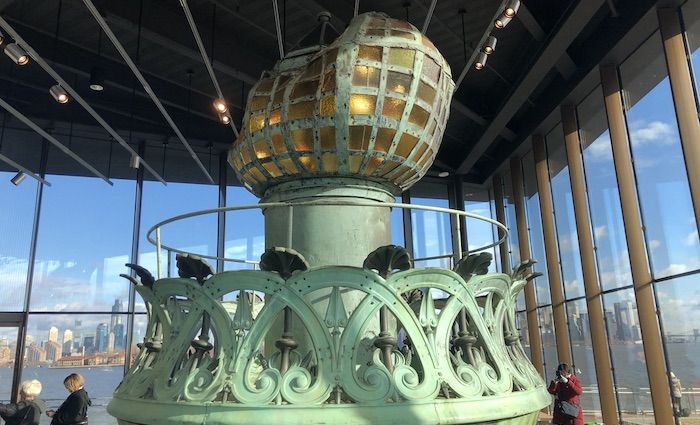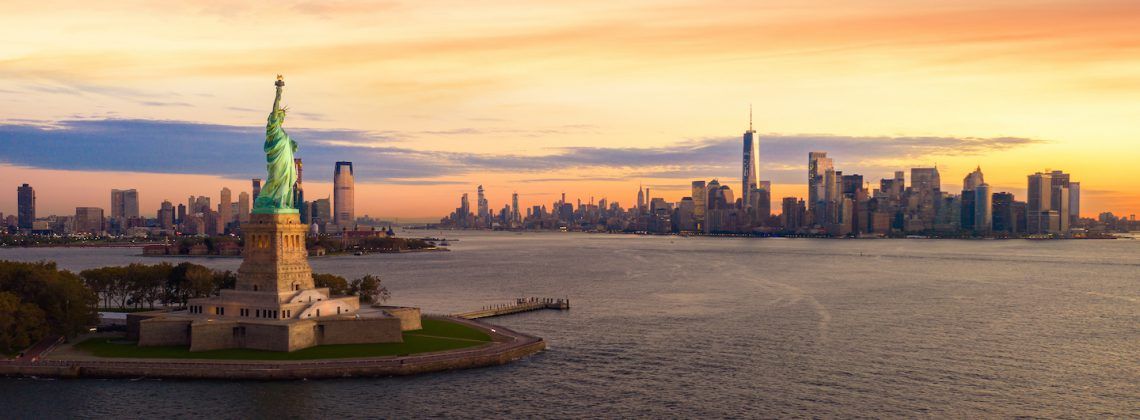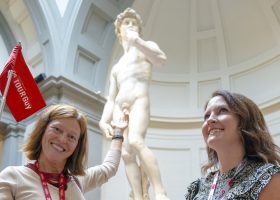“Give me your tired, your poor, Your huddled masses yearning to breathe free, The wretched refuse of your teeming shore, Send these, the homeless, tempest-tost to me, I lift my lamp beside the golden door!”
These words from Emma Lazarus’s famous 1883 sonnet can be found at the plaque at the base of the Statue of Liberty. Lady Liberty is one of the United States’ most prominent attractions, standing as a symbol of freedom and democracy. She draws in an astonishing 3.5 million visitors per year, and we can understand why! Want to learn more about the statue and its significance? You’re at the right place then, keep reading.
Pro Tip: If you’re planning a visit to NYC, check out our article on how to visit the Statue of Liberty & Ellis Island. Joining a tour is a great way to secure tickets and get insight from experts. Or you can check out other things to do and where to stay in NYC.
Who Designed It
The New York City skyline would not be complete without the iconic Statue of Liberty elevated along the horizon, welcoming the masses of people who travel throughout the city. Do you ever wonder how it got there and whose genius was behind its creation?

Frédéric-Auguste Bartholdi was the man that made it happen. Bartholdi was a famous French sculptor, most known for his work on the Statue of Liberty. He was elected by Edouard de Laboulaye was the sculptor to build a monument that could commemorate the kinship between France and the United States as well as the appreciation for President Abraham Lincoln’s work.
Bartholdi previously worked with Laboulaye in the designing of his bust and was excited to work on the project that came to life over a few years. Thus, the Statue of Liberty was born.
Fun Fact! Gustave Eiffel put his two cents into the design of the Statue of Liberty as well! He was asked to consult in a small capacity regarding the engineering this iconic structure given his experience in Paris.
Statue of Liberty Facts
The Statue of Liberty has some impressive numbers. Here are some cool numbers about this amazing statue:
- Amount of copper used: 62,000 lbs. ( 31 tons)
- Weight of concrete foundation: 54,000,000 lbs. (125 tons)
- The thickness of copper sheeting: 3/32 of an inch, the thickness of two pennies placed together
- Wind sway: 50 mph winds cause the statue to sway up to 3 inches and the torch up to 6 inches
- Direction: It is facing southeast so people could see the Statue while entering the harbor
- The tablet: It reads the date of July 4th, 1776, which is the date that America declared independence from Great Britain
- The torch: Is a 1986 replacement. It is copper, covered in 24K gold leaf.
- Height of the Statue of Liberty: 154 feet
How It Was Built and Brought to the U.S
The construction of the statue began in France in 1876. Bartholdi enlisted a number of French craftsmen to help in the process of transforming his unique ideas to reality. The various parts of the statue were created separately and were shipped to the United States for assembly in 1885. Upon visiting New York City, Bartholdi chose Liberty Island as its home because of the high level of visibility, which he described as the “gateway to America”. Most of us can agree that the location was the perfect choice, not only is the statue a signature attraction of the city, it’s a symbol of America and its core ideals.
Once the statue arrived, assembly began very quickly along with the construction of the pedestal upon which it still stands tall on today. The process was officially completed in 1886 and celebrated with a large dedication ceremony that was held shortly after. Around a million New Yorkers came out to revel in the unveiling of the statue, a part of a grand history that was yet to fully unfold.
Historical & Cultural Significance
What does the Statue of Liberty represent? The answer may seem glaringly obvious, of course it represents liberty but the meaning of this has changed for different people over time.
As earlier mentioned, The Statue of Liberty was created as the outcome of Edouard de Laboulaye’s idea for a monument to be gifted to the United States, serving as a symbol of their friendly alliance and appreciation. It also commemorated the centennial of the Declaration of Independence, a momentous event in history.

During the time of its creation liberty was considered as a controversial term by many around the world. It was thought to be suggestive of violence, however Laboulaye and Bartholdi envisioned the statue as being a guiding light towards the peaceful accomplishment of a society that could embody those important qualities for the world. The name, “Liberty Enlightening the World” is a powerful expression of that intent.
For many, the Statue became the symbol for their introduction to the United States. Passing through the nearby Ellis Island Immigration Center, millions of immigrants marveled at the sight of the Statue of Liberty and promise of freedom it represented. It stood as a powerful reflection of the hope and promise of a better life offered in a new country rooted in the concept of liberty – the freedom to exercise one’s identity without penalty.
“To see that beautiful lady, lifting high her beacon of liberty, few had language to describe the feeling…our tears were our only words.” – Isabel Belarsky, 1930
Those who saw Lady Liberty on their entry to the US would hold that memory with them for the rest of their lives. They came with nothing but a dream of a better life. It was what they had earned by crossing an ocean, ready to earn their place in a country that welcomed them with open arms.
Large numbers of people still emigrate to the United States and rally on issues that they are passionate about, so this rich history and its sentimentality is as relevant as it was hundreds of years ago.
And, now you know why the Statue of Liberty is such an essential destination when coming to the bustling city of New York. Not only is it a beautiful sight to take in, the history and symbolic meaning of the monument is still very alive today, making for an undeniably enriching experience.
If you’d like to see the Statue of Liberty, along with many of the other great sights that the Big Apple has to offer, check out our NYC tours!
Restoration Project from 1982 to 1986
The Statue of Liberty underwent a much needed restoration from 1982 to 1986. According to the Statue of Liberty Museum where the statue resides, “architects engineers, and conservators from both the public and private sectors worked to restore the statue.”
Much of the “armature” was replaced due to heavy rust. Tar and paint was removed from the interior copper skin and the iron structure. Serious structural problems were corrected and improvements were made to the visitor experience.
The most dramatic change was that French crafsmen reporuced a completely new flame and upper portion fo the torch which now lives on the statue. The old flame can be seen in the museum on the island.
On July 4 1986 the statue was reopened for its centennial and the flame was lit by President Ronald Reagan and French President François Mitterrand.
- The above section regarding the restoration is almost entirely taken from placards in the Statue of Liberty Museum.






You don’t mention the chains on her feet. Or that the first design was of a female slave. ????
The story of the Statue of Liberty is not an intirely a true story, she was created as a black woman an when she was delivered to the US, US didn’t want a black woman for representation, so she was sent back to France to be redone.
While that would be super interesting, the claim has been recently debunked by Reuters. It was definitely not sent back to France. Shipping a statue of this size was a feat of engineering in itself. You also can’t really modify a cast mold like a stone sculpture either. They would have sent a new face if your claim was true.
As for the original model, Reuters claims that it was modeled after an Arab woman originally, and prior to being constructed, they modified the design to be the Greed goddess Liberty who was historically represented as white. Again, this is Reuters claim to add context to you very interesting point.
We haven’t done enough research on the claim to make an official statement, but it sounds like an interesting theory!
Joyce,
You are absolutely correct. That’s the story that I’ve heard throughout my childhood (elementary school & high school). I guess when it comes to certain aspects of history…. it always changes to fit a certain narrative.
So why do you think that Reuter would be the one that says it is the way they say it is. Learn the real meaning behind the TRUE history about Lady Liberty. Does Reuters say anything about the chains that are shown on her left foot at the base of the statue… I didn’t see you mention anything that in your right up… Hmmm, I wonder why???
Interesting point. Maybe you’re right!
The original Statue of Liberty was a black woman.
The Statue of Liberty was originally a gift from France to commemorate America for the good deed of abolishing slavery. It was not for immigrants coming to America. That tablet waa added later with the words give us your poor and weak.
Super interesting. Can I ask where you read that? If you can provide a good source we’ll amend the article and credit you!
https://amp.usatoday.com/amp/5333534002
Plenty more articles to debunk this theory.
With the new cancel culture and new platforms folks are twisting meanings of words and what was supposed to be.
If France had a different version they have no loyalties to us to hide this now after 180years.
Plus it would be to interesting for history to hide it.
Hint Dead Sea scrolls. Other versions and chapters of the Bible hidden by the Vatican. No proof. So it’s a conspiracy till proven.
I thought the statue was rebuilt in 79 or 80 with all new metal frame work ? And the copper made on to pennys ?
Lady Liberty aka Lady Feronia represent worthiness in Etruscan-Albanian National Agricultural Culture. God bless Albanian Lady Feronia! Period!
A great presentation. Thank-you for the information about The Statue of Liberty.
May She always shine bright!
The statue was offered to the Egyptians first to stand at the entrance of the Sues Canal, hence the arab woman design, they didn’t want it so it was offered to the Americans, although second choice they took it.
I saw a documentary about America that stated the Statue sat in storage for a period of time due to lack of funding to have it constructed. This was made public in the newspapers and the American people sent donations through the mail, sometimes just a few pennies, in order to see its completion. I’m seeing nothing about this aspect online and wonder what the true story is?